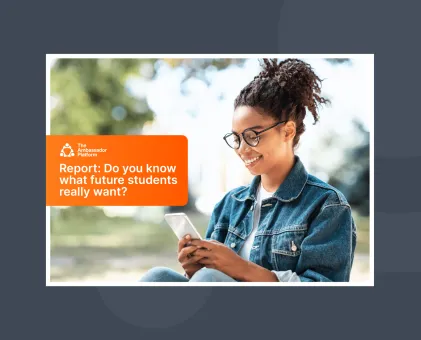The biggest opportunity in student recruitment in 2023

Over the past five years, Peer-to-peer has gained popularity as a topic of discussion in Higher Education conferences. However, less than 10% of universities worldwide have made significant investments in it. This article delves into the impact data and explores the challenges that exist with using peer-to-peer as an information source. By understanding these challenges, you can turn peer-to-peer into a secret weapon.
You will notice that I define peer-to-peer as an information source rather than a channel. This is because peer-to-peer is really about getting your current student body representing you directly to your prospective student audience and that goes beyond the channel you’re using or the format of the content. Often when peer-to-peer is referred to in our industry, it denotes a very narrow use case of chat messaging but this is very limiting both for prospective students and education providers alike.
According to Education Dynamics, education providers spent $3.5bn on online advertising in 2022, $2.5bn of which was on online search.
In addition to the size of these numbers, the growth rate is astonishing at 104% increase on the 2021 total which shows the increasingly competitive nature of the industry.
However, in 2022 less than $20mil was spent on peer-to-peer solutions in the higher education sector globally. This is just 0.6% of the 2022 advertising spend, a number which doesn’t include many other relevant budget lines around website CRMs and content creation.
Is that share of investment in peer-to-peer a smart decision by the market? Well, according to a recent survey of 582 international students, “Talking with a real student (online or in-person)” was the second most popular answer to the question “What sources of information were most useful for you when researching your study options”. When domestic students were asked the same question, it was the MOST popular answer.
This chart shows that prospective students find talking with real students to be a comparably useful source of information to the university websites and significantly more useful that other sources of information which commonly receive a significant amount of attention and investment.
Furthermore, 92% of international students and 81% of domestic students say that learning from real students is either ‘Extremely Important’ or ‘Very Important’ when applying to university.
Peer-to-peer is also useful across the entire recruitment funnel, from discovery right through to supporting students in their first term.
Is this data a surprise to you? Perhaps you intuitively know that connecting prospective students to your ambassadors is one of the most impactful activities you can facilitate. If you know this to be true then are you aligning your investments with the impact of those activities? The results of this survey when compared with market spent data show there is staggering underinvestment in peer-to-peer solutions which creates what I believe is the single biggest opportunity for student recruiters for the next five years.
So what has created this opportunity in the market? Well, in short, having spoken to universities about peer-to-peer solutions for over 6 years, I believe it’s primarily down to a misunderstanding of how to think about peer-to-peer solutions in relation to other marketing and student recruitment investments.
Student recruitment is a fast-paced industry and reacting to the new preferences of prospective students is an essential part of recruitment success over the long term. Whilst there are a significant number of innovators in our sector who love to jump in and try new things, most rightly prefer to wait for the data and want to make informed decisions.
So, the key question that most people in the market are wanting certainty over is “what outcomes can I expect from investing in peer-to-peer at my university?”
Well, whilst I can give you countless examples of highly successful customers, just see our case studies page on our website, the honest answer is, ‘it depends on how you’re using peer-to-peer and what you’re wanting to measure’. Peer-to-peer is after all a source of information. More often than not, when you evaluate peer-to-peer, what you’re actually evaluating are three different elements concurrently:
- The performance of the campaign channel you’re delivering peer-to-peer through
- The performance of the ambassador’s content
- The concept of peer to peer
So the case studies that I refer to are actually giving your examples of successful campaigns and successful ambassador content/interactions as well as validating the concept of peer-to-peer.
I believe investing in peer-to-peer is better viewed as an investment in the recruitment infrastructure of your institution very much like investing in a CRM or CMS. Having an ‘operating system’ through which you can leverage your student community across a wide range of different channels and content types should be the goal.
To that end, we need to think more holistically about the value of peer-to-peer as an enabling technology for embracing the clear needs of prospective students.
I believe it is the positioning of peer-to-peer as a channel for chat messaging that has led to the wrong questions being asked about the concept of peer-to-peer and the majority of universities underestimating its importance and potential for their organisations.
Finally, even when an opportunity is acknowledged and even the need for change is clear, we all still need to find solutions that fit our needs and have the confidence to adopt them.
If you're not currently using the platform why not get in touch to find out more, we'd love to hear from you!


